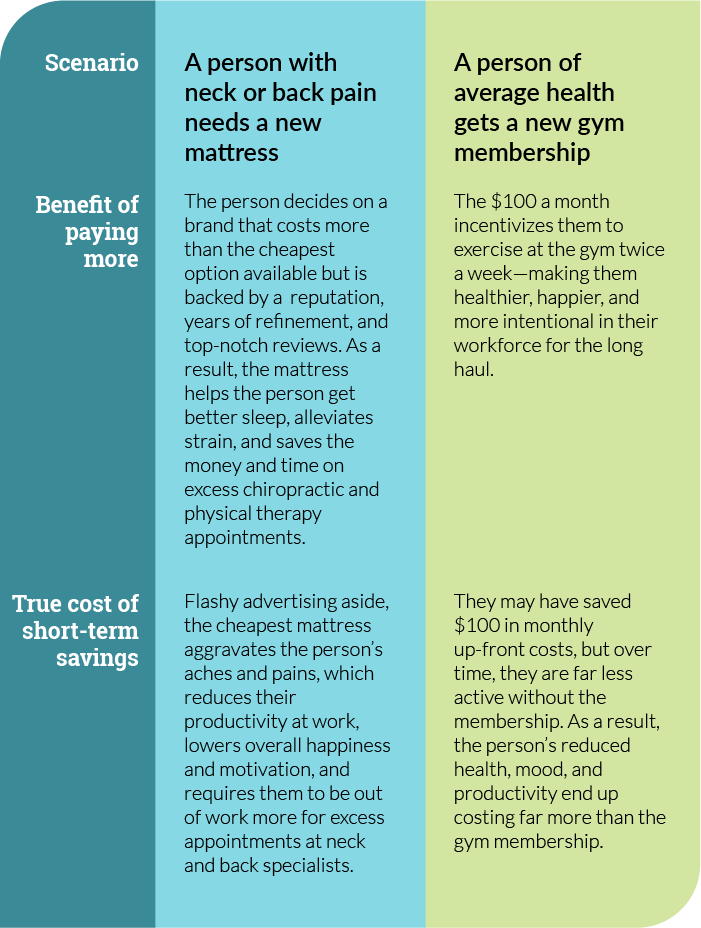Organizations faced with steadily rising benefit costs are looking for ways to get spending under control. Tactics that deliver short-term savings don't solve the underlying issues; they actually set you up for significant cost increases later.
But there is a more holistic approach to balancing healthcare spending with benefits.
Here are five reasons why focusing on the total cost of care means quality benefits — and savings big enough to flatten your cost curve for good.

Reason 1: Gaining a bigger view
First off: We understand. At a time when organizations are seeing health plans trend 6.5 percent higher year over year, getting costs under control is a top priority.
While it’s a natural response to want to remove the thing causing pain (to your balance sheet, in this instance), too many organizations make reactive cuts and miss an important truth: Everything is connected — especially in healthcare.
A high-deductible healthcare plan may save your organization some short-term money, but it also transfers cost increases onto employees which discourages routine and preventive care. And delaying care is in no one’s best interest. Pretty soon, even apparently healthy employees need treatment for more serious (and expensive) conditions which could have been managed or prevented with low- to no-cost primary care at the center of your benefits strategy.

Reason 2: Freedom to try new solutions
Employees who can’t afford access to routine and preventive care services take more sick days, underperform, or end up leaving their job entirely, citing mediocre benefits as a key factor. But when you weigh the total cost of care along with employee health, absenteeism, retention, and recruiting, it sets you on a path to find multifaceted solutions—solutions that keep what matters in balance. After all, replacing an employee costs 50 to 60 percent of their annual salary. It’s important to offer proven benefits your team wants today so they’ll be motivated and equipped to be your best team tomorrow.
One option is to reallocate some of your benefit spending into advanced primary care (APC) that extends unlimited primary care to members — which is sufficient to address 80 to 90 percent of all care needs regardless of members’ risk or population.

Reason 3: Proven by everyday life
Embracing a high-level view by considering the total cost of care might not be commonplace in traditional healthcare yet, but it’s considered a wise part of daily living.
Here are two examples of how an effective “total cost of care” mindset shows up in our daily lives. Let’s consider the benefits of reallocating some of a household budget for a gym membership and a better mattress.

As we understand from everyday examples like the two provided above, reallocating a portion of a budget towards proven solutions is a great way to achieve long-term benefits that vastly exceed the reallocated funds.

Reason 4: Measured efficiency
A “total cost of care” approach means your organization still trims what’s not working for your balance sheet or your workforce — but it makes cuts in a more methodical way. With benefits being a significant portion of overall expenses, a piecemeal approach including granular adjustments to benefits can create a lot of busywork without helping to flatten the cost curve in a sustainable way. Instead, think of your benefits package like a diversified investment portfolio that is filled with varied choices and given the time to demonstrate a healthy return on investment.

Reason 5: It’s the future
“Health in 2040 will be a world apart from what we have now.”
Deloitte forecasts a future where value-based models like APC equip patients to take greater ownership of their own health goals—generating significant savings as a result.
How significant? Deloitte projects a $3.5 trillion dollar well-being dividend for organizations willing to embrace value-based care models.
A modest shift with exponential benefits
Vera’s APC care puts primary care at the center of members’ health journey with unlimited low- to no-cost routine and preventive services including screenings and annual wellness appointments. Members receive in-center or virtual support from qualified providers, empathetic health coaches, and attuned behavioral health clinicians. It’s a truly sustainable way to keep an eye on your bottom line, reduce your overall healthcare spend, and deliver verified benefits for your workforce.
Vera’s APC is not only proven, it’s the reason we’re a national leader of a healthcare revolution. Learn how it can benefit you by checking out our new APC guide.